Simultaneous Color Contrast Increments with Complexity and Identity of the Target Stimulus
Abstract
1. Introduction
2. Methods
2.1. Participants
2.2. Assessment of Simultaneous Color Contrast
2.2.1. Experiment 1
2.2.2. Experiment 2
2.3. General Procedure and Equipment Details
2.4. Statistical Analyses
3. Results
3.1. Experiment 1
3.2. Experiment 2
4. Discussion
Author Contributions
Funding
Institutional Review Board Statement
Informed Consent Statement
Data Availability Statement
Acknowledgments
Conflicts of Interest
References
- D’Zmura, M. Color in Visual Search. Vision Res. 1991, 31, 951–966. [Google Scholar] [CrossRef]
- Grasso, P.A.; Anobile, G.; Arrighi, R.; Burr, D.C.; Cicchini, G.M. Numerosity Perception Is Tuned to Salient Environmental Features. iScience 2022, 25, 104104. [Google Scholar] [CrossRef] [PubMed]
- Hansen, T.; Olkkonen, M.; Walter, S.; Gegenfurtner, K.R. Memory Modulates Color Appearance. Nat. Neurosci. 2006, 9, 1367–1368. [Google Scholar] [CrossRef] [PubMed]
- Caponi, C.; Castaldi, E.; Grasso, P.A.; Arrighi, R. Feature-Selective Adaptation of Numerosity Perception. Proc. B 2025, 292, 1841. [Google Scholar] [CrossRef]
- Gegenfurtner, K.R. Cortical Mechanisms of Colour Vision. Nat. Rev. Neurosci. 2003, 4, 563–572. [Google Scholar] [CrossRef]
- Stockman, A.; Sharpe, L.T. The Spectral Sensitivities of the Middle- and Long-Wavelength-Sensitive Cones Derived from Measurements in Observers of Known Genotype. Vision Res. 2000, 40, 1711–1737. [Google Scholar] [CrossRef] [PubMed]
- Hurlbert, A.; Wolf, K. Color Contrast: A Contributory Mechanism to Color Constancy. Prog. Brain Res. 2004, 144, 145–160. [Google Scholar]
- Lotto, R.B.; Purves, D. An Empirical Explanation of Color Contrast. Proc. Natl. Acad. Sci. USA 2000, 97, 12834–12839. [Google Scholar] [CrossRef] [PubMed]
- Ratnasingam, S.; Anderson, B.L. What Predicts the Strength of Simultaneous Color Contrast. J. Vis. 2017, 17, 13. [Google Scholar] [CrossRef] [PubMed][Green Version]
- Bosten, J.M.; Mollon, J.D. Kirschmann’s Fourth Law. Vision Res. 2012, 53, 40–46. [Google Scholar] [CrossRef] [PubMed]
- Ekroll, V.; Faul, F. A Simple Model Describes Large Individual Differences in Simultaneous Colour Contrast. Vision Res. 2009, 49, 2261–2272. [Google Scholar] [CrossRef][Green Version]
- Ekroll, V.; Faul, F.; Wendt, G. The Strengths of Simultaneous Colour Contrast and the Gamut Expansion Effect Correlate across Observers: Evidence for a Common Mechanism. Vision Res. 2011, 51, 311–322. [Google Scholar] [CrossRef] [PubMed]
- Kaneko, S.; Murakami, I.; Kuriki, I.; Peterzell, D.H. Individual Variability in Simultaneous Contrast for Color and Brightness: Small Sample Factor Analyses Reveal Separate Induction Processes for Short and Long Flashes. Iperception 2018, 9, 1–22. [Google Scholar] [CrossRef] [PubMed]
- Kaneko, S.; Murakami, I. Flashed Stimulation Produces Strong Simultaneous Brightness and Color Contrast. J. Vis. 2012, 12, 1. [Google Scholar] [CrossRef]
- Kaneko, S.; Anstis, S.; Kuriki, I. Brief Presentation Enhances Various Simultaneous Contrast Effects. J. Vis. 2017, 17, 7. [Google Scholar] [CrossRef] [PubMed]
- Ekroll, V.; Faul, F. Transparency Perception: The Key to Understanding Simultaneous Color Contrast. J. Opt. Soc. Am. A 2013, 30, 342–352. [Google Scholar] [CrossRef] [PubMed]
- Snodgrass, J.G.; Vanderwart, M. A Standardized Set of 260 Pictures: Norms for Name Agreement, Image Agreement, Familiarity, and Visual Complexity. J. Exp. Psychol. Hum. Learn. Mem. 1980, 6, 174–215. [Google Scholar] [CrossRef] [PubMed]
- Heylighen, F. The Growth of Structural and Functional Complexity During Evolution. Evol. Complex. 1999, 8, 17–44. [Google Scholar]
- Smith, A.R. Color Gamut Transform Pairs. In Proceedings of the 5th Annual Conference on Computer Graphics and Interactive Techniques; SIGGRAPH: New York, NY, USA, 1978. [Google Scholar]
- Kleiner, M.; Brainard, D.H.; Pelli, D.G.; Broussard, C.; Wolf, T.; Niehorster, D. What’s New in Psychtoolbox-3? Perception 2007, 36, 1–16. [Google Scholar]
- Westland, S.; Ripamonti, C.; Cheung, V. Computational Colour Science Using MATLAB®, 2nd ed.; John Wiley & Sons: Hoboken, NJ, USA, 2012. [Google Scholar]
- Greenhouse, S.W.; Geisser, S. On Methods in the Analysis of Profile Data. Psychometrika 1959, 24, 95–112. [Google Scholar] [CrossRef]
- Soranzo, A. Simultaneous Contrast, Simultaneous Brightness Contrast, Simultaneous Color. In Encyclopedia of Color Science and Technology; Springer: New York, NY, USA, 2015. [Google Scholar]
- Kanematsu, T.; Koida, K. Large Enhancement of Simultaneous Color Contrast by White Flanking Contours. Sci. Rep. 2020, 10, 20136. [Google Scholar] [CrossRef] [PubMed]
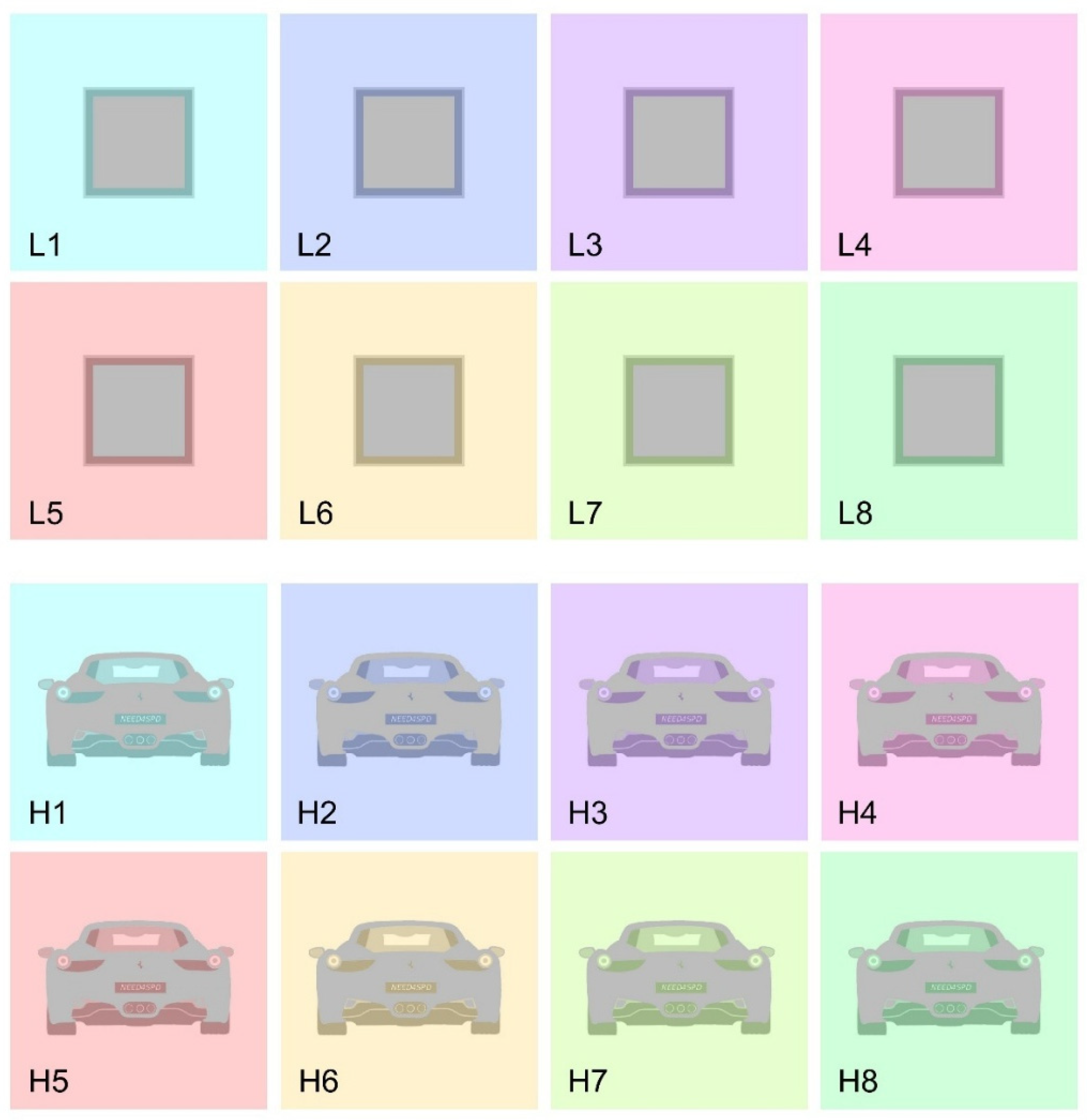
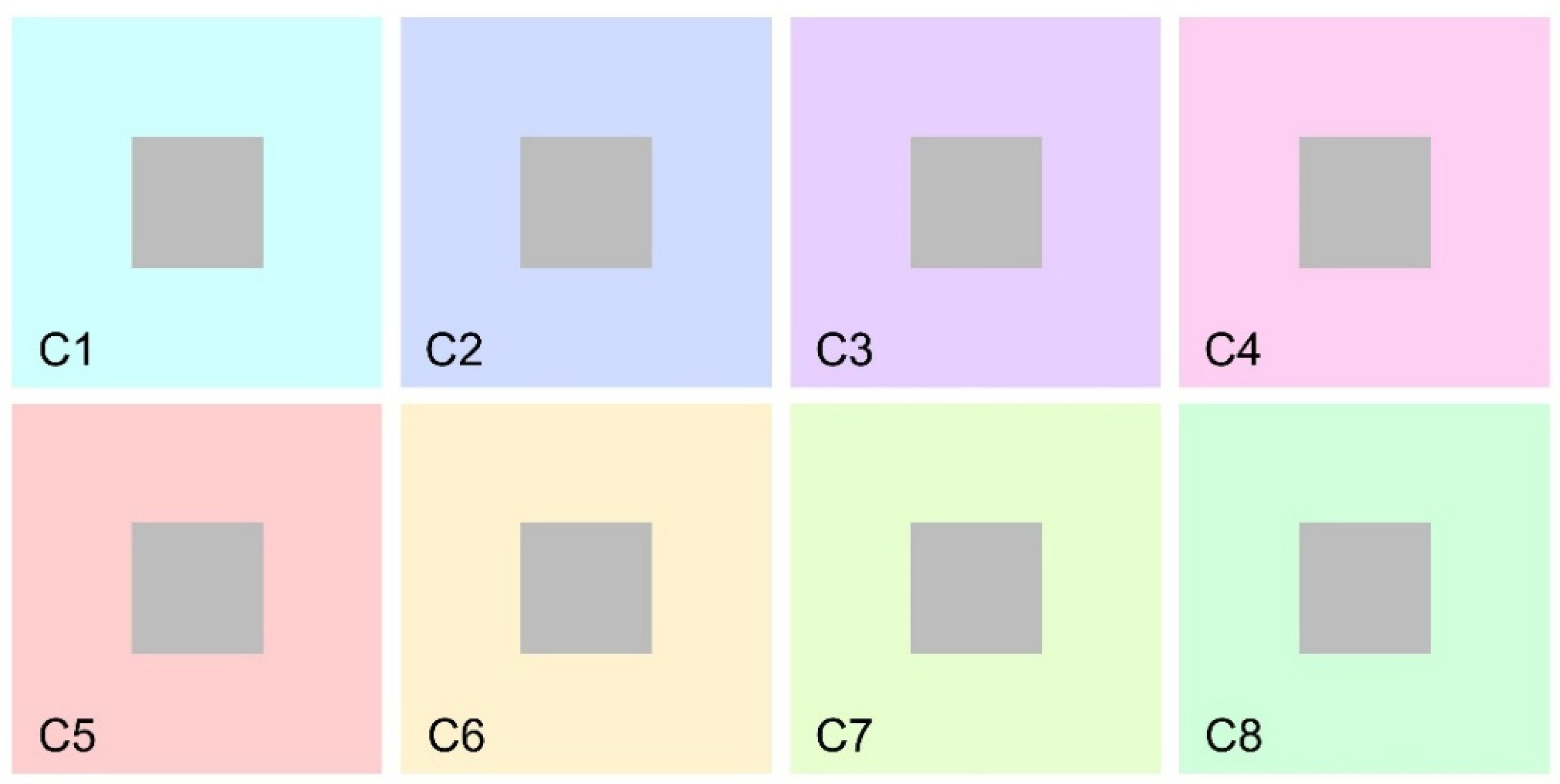


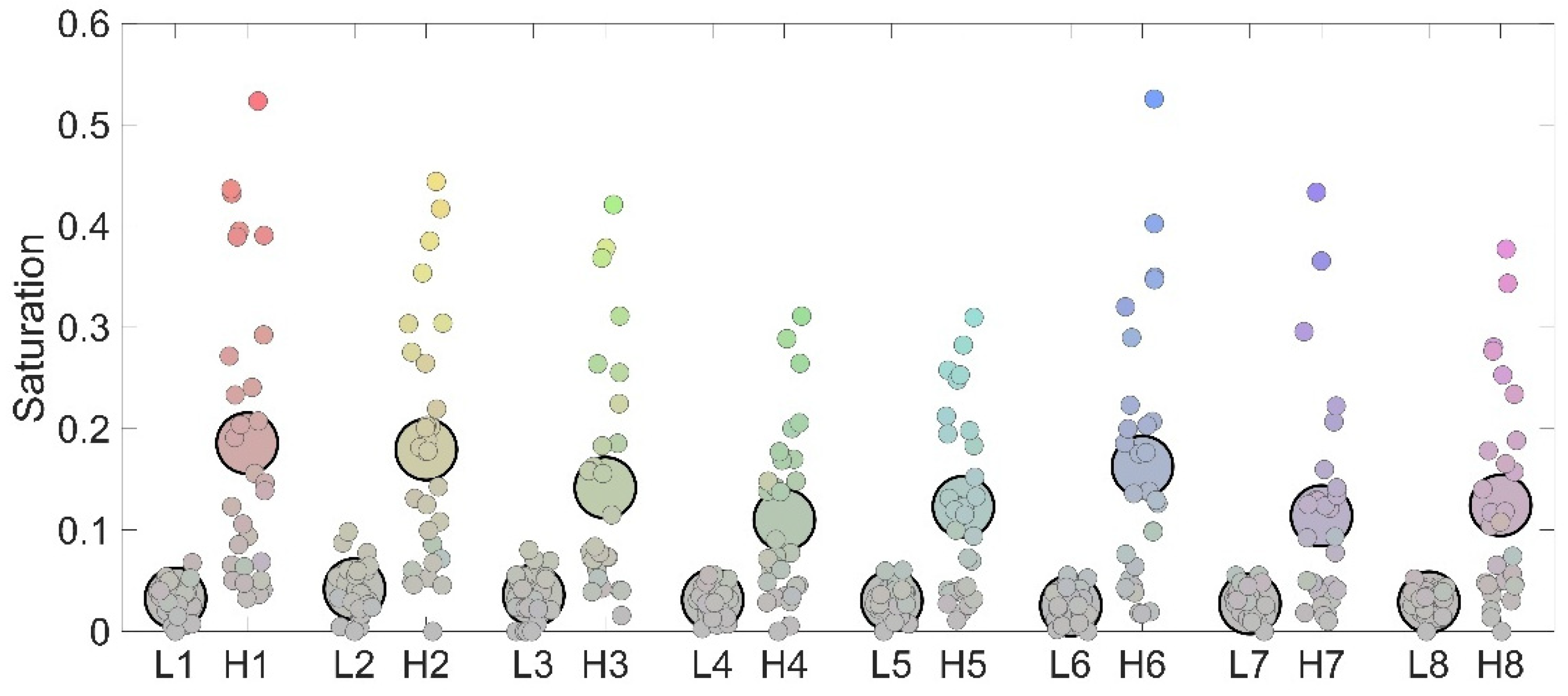
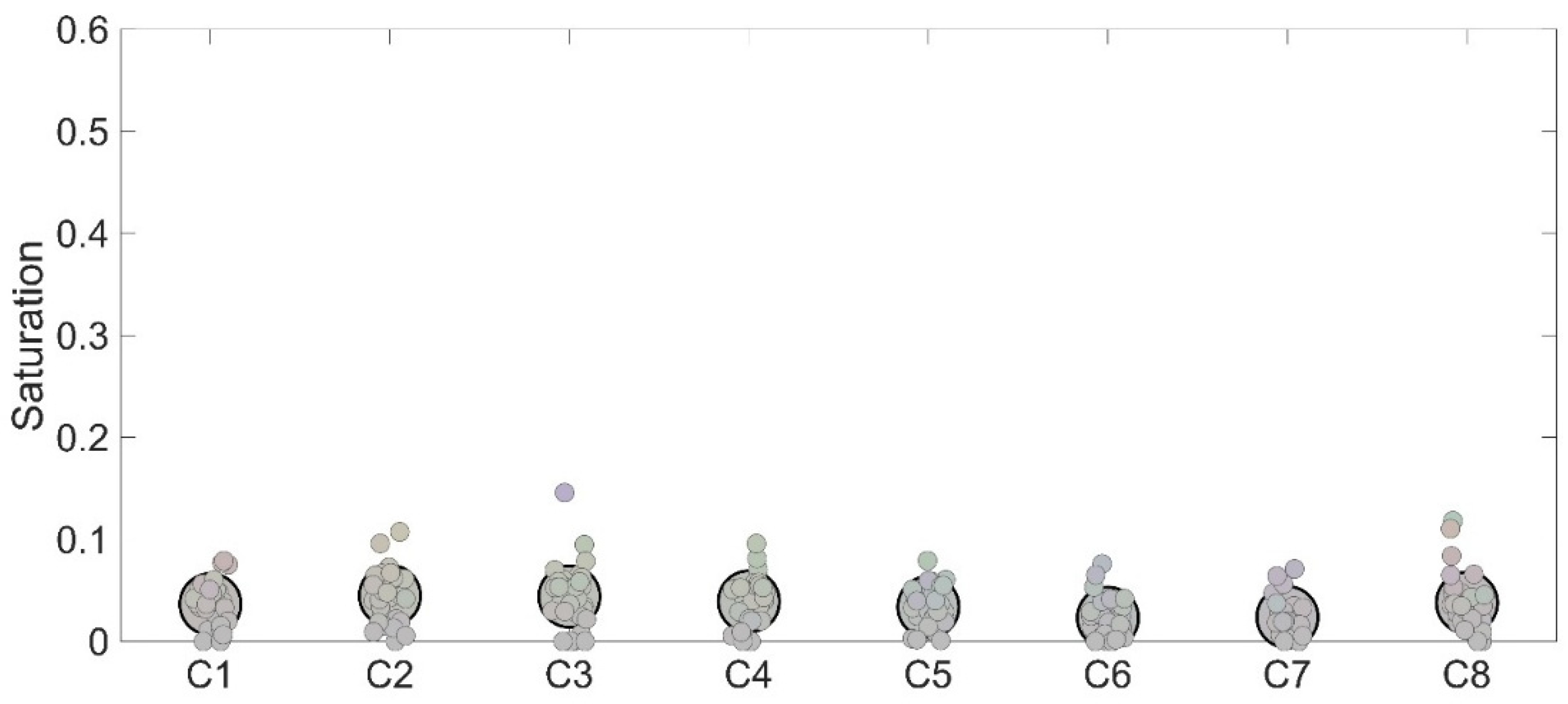
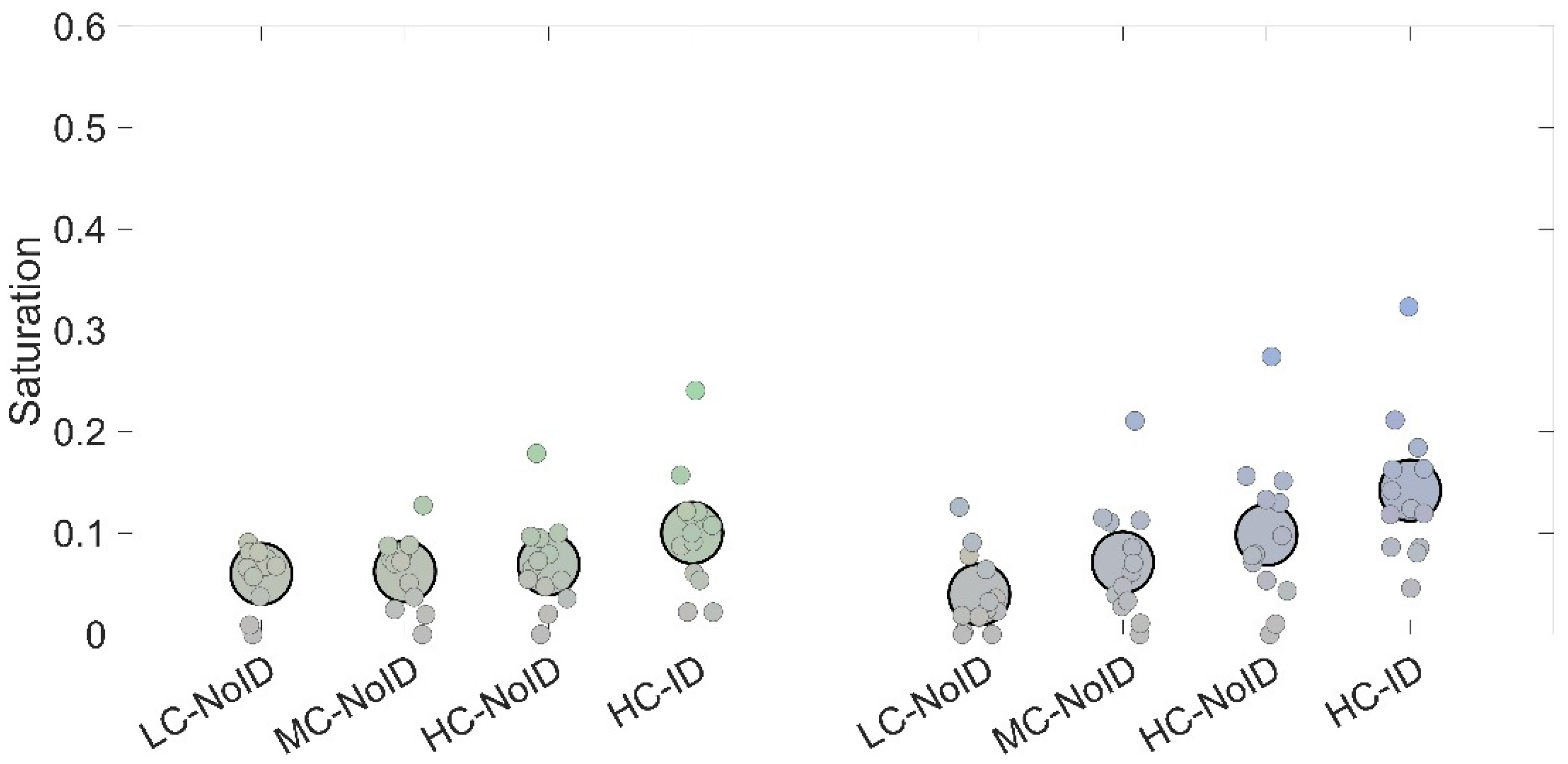
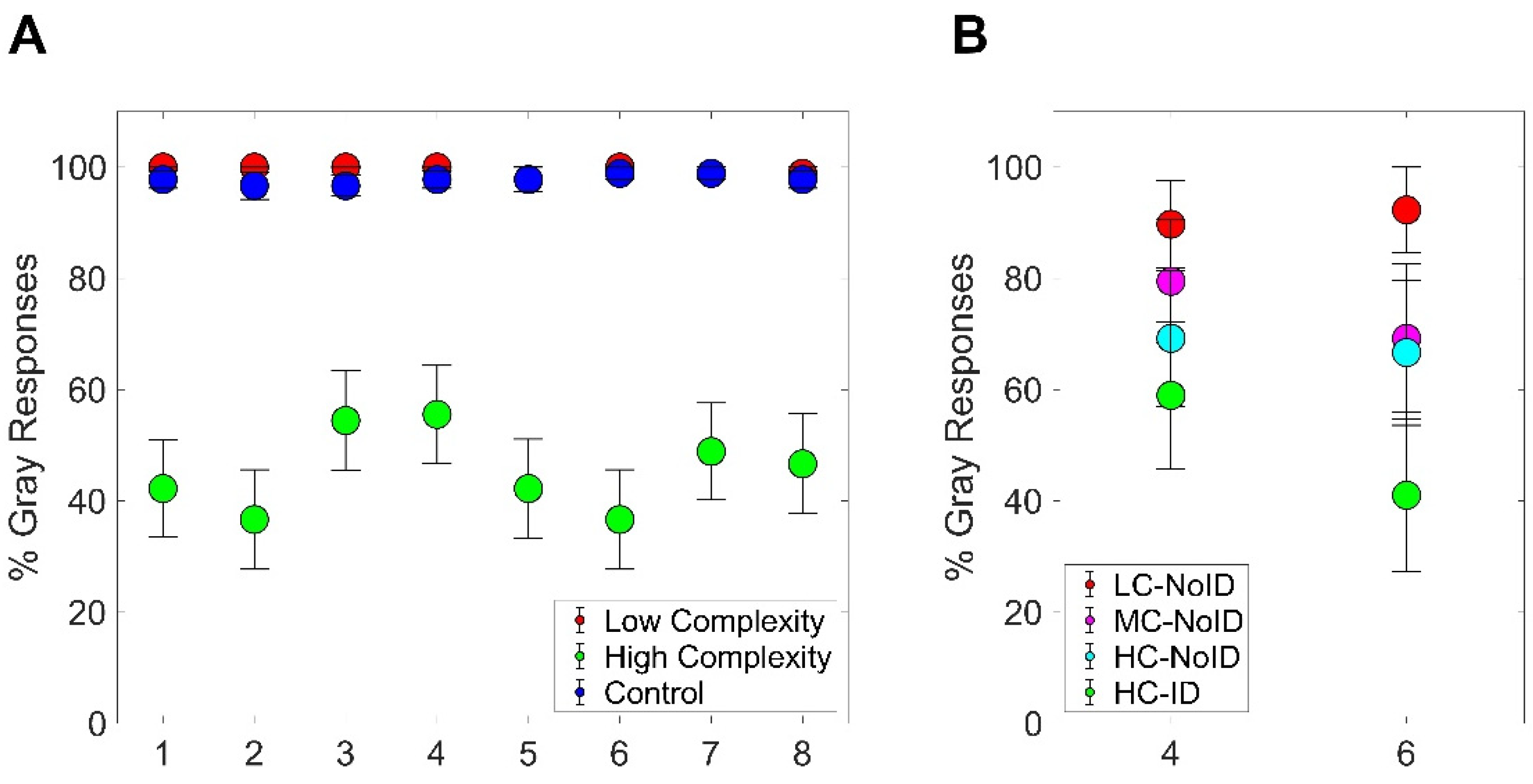
| Gogvals | |
|---|---|
| 2.24 | 0.91 |
| 2.25 | 0.92 |
| 2.21 | 0.92 |
| M | ||
|---|---|---|
| 82.8 | 37.7 | 29.5 |
| 37.8 | 102.9 | 13.8 |
| 2.3 | 16.3 | 150.5 |
Disclaimer/Publisher’s Note: The statements, opinions and data contained in all publications are solely those of the individual author(s) and contributor(s) and not of MDPI and/or the editor(s). MDPI and/or the editor(s) disclaim responsibility for any injury to people or property resulting from any ideas, methods, instructions or products referred to in the content. |
© 2025 by the authors. Licensee MDPI, Basel, Switzerland. This article is an open access article distributed under the terms and conditions of the Creative Commons Attribution (CC BY) license (https://creativecommons.org/licenses/by/4.0/).
Share and Cite
Grasso, P.A.; Tommasi, F.; Franconi, R.; Baldanzi, E.; Farini, A.; Gurioli, M. Simultaneous Color Contrast Increments with Complexity and Identity of the Target Stimulus. Life 2025, 15, 257. https://doi.org/10.3390/life15020257
Grasso PA, Tommasi F, Franconi R, Baldanzi E, Farini A, Gurioli M. Simultaneous Color Contrast Increments with Complexity and Identity of the Target Stimulus. Life. 2025; 15(2):257. https://doi.org/10.3390/life15020257
Chicago/Turabian StyleGrasso, Paolo A., Federico Tommasi, Rebecca Franconi, Elisabetta Baldanzi, Alessandro Farini, and Massimo Gurioli. 2025. "Simultaneous Color Contrast Increments with Complexity and Identity of the Target Stimulus" Life 15, no. 2: 257. https://doi.org/10.3390/life15020257
APA StyleGrasso, P. A., Tommasi, F., Franconi, R., Baldanzi, E., Farini, A., & Gurioli, M. (2025). Simultaneous Color Contrast Increments with Complexity and Identity of the Target Stimulus. Life, 15(2), 257. https://doi.org/10.3390/life15020257





